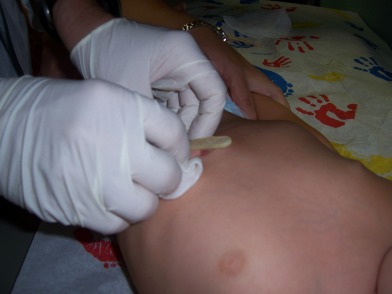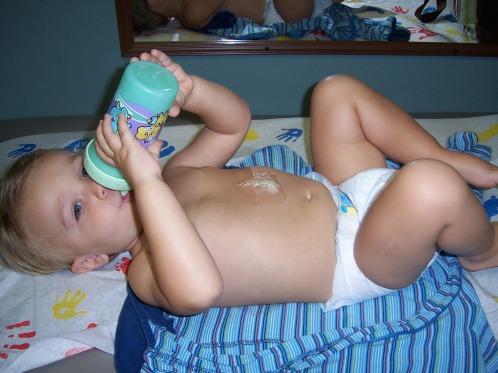Photos of G-Button and Removal
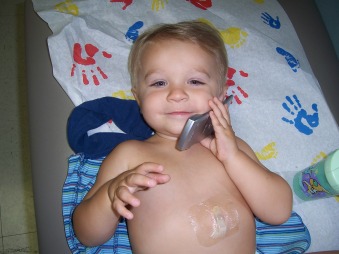
*** THE FOLLOWING PHOTOS MAY NOT BE PLEASANT IF YOU HAVE A VERY WEAK STOMACH. THEY ARE INTENDED TO HELP PARENTS WHO ARE DEALING WITH G-BUTTONS AND CONCERNED ABOUT THE REMOVAL, HEALING, AND SCARRING.***
Garrett had his G-button for 10 months. These photos were taken the day of the removal and then days following, showing the rapid healing. And yes, that's my mom he is "talking to" on the phone! The placement was done under general anesthesia, and it was removed in the outpatient office with a topical numbing medicine applied thirty minuted before it was removed. Garrett had a Bard button, and it was only changed once. It was changed in the operating room under general anesthesia. With another type button, a Mickey-E, the parent can change the button at home. The Bard must be done by the surgeon. The hole left after the removal healed quickly, but his muscle did not grow correctly where the hole had been, thus causing a hernia. That was repaired in the operating room under general anesthesia 2 months after the button was removed. He has been button-free since August 2007.
The Surgeon Pulls It Out!
The Button Hole
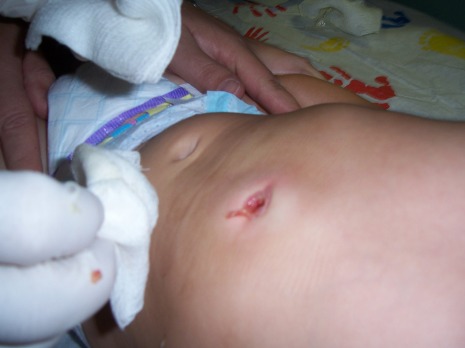
It looks a bit scary, but it was very quick, and we were relieved to know our big boy was eating enough to not need this contraption any longer!!
G-Button
The Bard Button
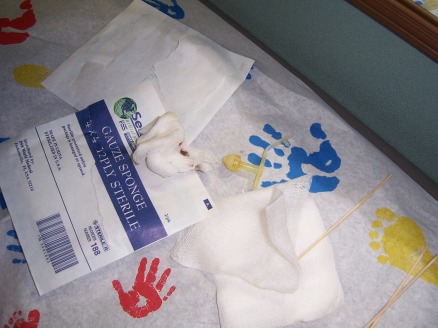
That TINY thing you see in the middle of the photo that is a bit yellow colored is the button. I had no idea how small it really was! The mushroom shaped piece was inside of his stomach, and the vertical straight piece was flat against his skin. It has a little flap on it with a stopper that closes the button when the button is not in use. The stopper piece is open in this photo.
Therapy
There is so much to share in this area, but for now I would like to say thank you to all of the hours of hard work so many therapists have invested in Garrett. His is moving forward, and it is because of these therapists who have loved him and pushed him. Over the past year, Garrett's therapy schedule has included:
PER WEEK:
2 hours pool physical therapy
2 hours private speech therapy
horseback riding at home once to twice per week
Garrett receives these services through our local public school system.
Occupational Therapy-monthly consult
Speech Therapy- 30 minutes twice per week
Adaptive Physical Education- weekly
Special Instruction- He is enrolled in a reverse inclusion special education class for 4 year old children . Reverse inclusion means that 4 or 5 special education students are in a class where 4-5 typical 4 year old children are brought in to join them for the year.
He has had an IEP for almost a year as of March 2010.
GI and Nutrition

Garrett was a good nurser from the beginning, except that he never wanted to open his mouth wide. I had pumped milk beginning at his one month birthday, and I stored enough to be able to leave him with people and not need to supplement with formula. I began trying to give him a bottle at three months of age. He wanted nothing to do with that. My husband tried, and no luck. He tried when I was not in the house, thinking that if he knew I was there or smelled me, he would certainly not take a bottle. But no. So we stopped trying for a while, and Garrett became my traveling buddy. Thanks to my mom, he traveled to three adventure races or more, and a half marathon!!! I was a committed breastfeeding mom and feeling a bit trapped, but I loved it just the same.
At 6 months old, we began offering Garrett cereals...rice or oatmeal mixed with breast milk. He refused it. We offered some baby foods..no. We tried the bottle again with breast milk, then the sippy cup. He refused and even panicked and screamed when we tried. A pediatrician recommended taking a break from that and letting him take his natural course. She said that when he was ready to eat he would show interest such as grabbing for my food when he was in my lap. It just never happened.
At almost 12 months, we re-introduced the spoon and foods. Garrett would eat one bite and then go into a raging fit of head slamming, screaming and slapping his face. We saw a GI doctor who prescribed the reflux medication Prevacid and recommended continuing to try foods. By 14 months I felt hopeless and Garrett was waking at night and nursing, and if he had no food by mouth besided breast milk, he was more comfortable. I was taking in the amount of calories that physicians recommended for feeding him. He was falling off the growth chart and was losing energy. One pediatrician assured me that children can nurse for up to two years with no supplementation and be just fine. That made me feel better, so we backed off of the foods again and I just nursed and nursed.
Then the painful episodes began to accompany nursing and then at night they became frequent. Keep in mind that until he was a year he had slept in a car seat and slept 12 hours per night. He was hospitalized for dehydration and testing in November 2006, and an NG tube was placed so he could receive additional nutrition. Tests showed his short term nutrition to be poor but his long term to be appropriate. No other tests were run due to lack of communication at the local children's hospital, so we drove to Texas Children's Hospital in Houston where after three weeks of tests, Garrett had a g-button placed while he was having a muscle biopsy done. A pH probe showed mild to moderate reflux, and he had slightly delayed gastric emptying. We went home on a 24 hour pump of Pediasure Enteral Formula with fiber, and we were advised not to offer any foods, but to continue nursing and tube feeding. After two months on Pediasure and breast milk, the therapists helped us try to start foods again. The foods did not work, so we stopped. He would panic and rage. The sippy cup was introduced, and a brilliant speech therapist found that Garrett could not use his mouth appropriately to get the liquid in his mouth to come together and then be sent down the throat by the tongue. She had me purchase a Thick-It, a liquid thickener used frequently with stroke patients. We began to thicken Pediasure to a pudding-like consistency and offer it with a straw. After a while he would drink 2-4 ounces through a straw. Within 2 months he worked up to using less and less Thick-It and eventually was able to use a sippy cup with pediasure and no other help.
We continued to reintroduce foods, and the powdered baby cereals became a hit, and soon after, he would eat some baby food fruits.
His first solid food was a waffle, and he soon learned to love flautas from our local Mexican restaurant!! How strange!!
He had his g-button about 9 months. We had it removed after we had not used it for anything for 3 months.
As of June 2008, he would sometimes eat table food, sometimes only eat stage 3 baby foods, and occasionally wouldl only drink. He drank soy milk as we have avoided dairy because of his constipation.
At 3.5 years, Garrett could eat most things without problems. He used a sippy cup and preferred vanilla soy milk over other beverages. He could feed himself, although VERY MESSY!!!
At 4.5 years as of December, 2009, Garrett still takes one cap of Miralax's generic form daily but stills gets constipated. He is still in diapers. He can eat anything he willl eat, but prefers pasta, chicken nuggets, and pizza...all very bad for his tummy!!! So we push lots of corn mixed into everything, as well as green peas, apple and peaches. He is currently bumming LOTS of granola cereal with raisins from Daddy-O when Daddy-O is home!!! He is back on Prevacid as the last scope showed redness all the way up to his upper throat....still refluxing. He makes some strange regeretating noises sometimes after he eats now and laughs about it. It sounds like many loud, wet burps!! He CAN self-feed, but with some meal items and some time constraints, we help him. He still keeps a raspy voice, part from reflux, nodules on his vocal cords from screaming, and from low tone. He still uses a sippy cup, but at school can drink milk out of those obnoxious milk bags!!
Garrett's Milestones
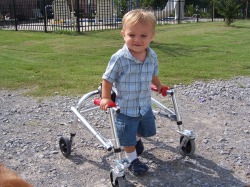
I have to add this photo because it represents the interesting order in which Garrett has accomplished things. The story behind the photo is this: Garrett seemed to be nowhere near walking independently in the summer of 2007, and approaching his second birthday, another mom I met in a hypotonia online group said to go ahead and get a walker for Garrett before it seemed he needed one. She said that many times the child will surprise the parents and therapists and give it a shot! So we had the pediatrician write the script, the therapist ordered the right reverse walker with certain wheels that turned in the front and wheels on the back that would not go backwards. It also had a hip stabilizer to hold his hips in the center of the walker for more stabilization. He got the walker a few weeks later. After three days using the walker, the week he turned two HE WALKED UNASSISTED for the first time!!!
Rolling over: 7 months one way, but not both. I think it was front to back as he hated to be on his stomach.
Sitting up: 9 months assisted as he would fall over easily
Sitting up with no support: 10 months
Getting into sitting up position by himself: 17 months
Crawling : never did and still will not for more than 6 feet.
Bum Scooting : 21months. This was his way of acooting on his bottom anywhere he wanted to go. He alternated legs coming to the center and alternated using his hands on the floor behind himself. He will still do this occasionally when he is tired.
Pulling to stand: 21 months
Walking: 24 months
Jumping.......almost at 3.5 years
Running.......3.5 years
First word: around 30 months began so say Mama and Dada and try to say tractor to the tune of Ta Ta.
Language... At 3.5 years he is saying a few two and three word sentences. Many he ends in "me," which is very funny. "I wan eatme! Wan go ride tractor, me! Wan go outside, me!"
Sleep: As of January 2009, Garrett sleeps 10-11 hours at night and takes a 2 hour nap each day. He sleeps through the night and nap without waking.
Garrett's Story

Garrett was born on July 17, 2005. He was full term and weighed 8 pounds, 11 ounces. In the hospital, all was perfectly normal, and he began breastfeeding with no problems except he never wanted to open his mouth very wide. We wrote it off as being a lazy boy! The first months were wonderful except he would wake up at around 2:30 each morning sounding like he was congested. I would get him out of the crib, nurse him, place him into his car seat in the crib to elevate his head for the congestion, and he would sleep until 7 in the morning. One night we had gone out to dinner where I nursed him while we were out, and we left him in the car seat in the crib overnight. He slept 12 hours straight, so until he was a year old, he slept in his car seat in the crib. He was comfortable, went to sleep without fussing, and slept all night. At 12 months, we decided to try putting him to bed without his car seat, and for a couple of weeks he fought it, but he finally slept 9 hours each night for a week or so.....then "IT" started. He began to wake more at night and I would nurse him and place him back into his crib. Then I began facing some facts I had been ignoring for some time. I had noticed he had slipped down the growth charts. He would not drink anything from a cup or bottle, and he would have screaming fits slapping his face and banging his head on his chair when given any babyfoods or other foods. He was not getting into a sitting position, was not bearing any weight on his legs, and was not crawling. He HATED being on his tubby and always had. We went to a GI doctor who prescribed Prevacid for reflux thinking this is what was bothering him at night...nighttime reflux. Then he began waking more at night. Then in November 2006, when Garrett was 16 months old, we began speech therapy for language and feeding therapies. Meanwhile, we had seen one of our pediatricians as we usually see one doctor in particular, but she was out due to a family medical tragedy. She had labeled Garrett FTT, or failure to thrive, developmentally delayed, hypotonia, and speech delayed. She sent us to get blood work done that same day and sent us to a local neurologist who ordered an MRI and more blood tests. The blood work was normal except for a bit elevated CK levels. The MRI showed nothing of concern. The neurologist mentioned the possability of a muscle biopsy in the future but left it at that for the time being. We planned to just see her again in 6 months unless things got any worse. We made it to two speech therapy appointments and one occupational therapy appointment before things went from not-so-great to worse. I took Garrett to see a pediatrician on a Saturday morning after he began to run a fever and had vomited after nursing that morning. The physician dismissed it as a stomach virus and sent us home. On Monday he was no better, and he had been up screaming in pain, throwing himself backwards, arching his back and was just plain miserable for two days with no sleep. We took him to yet another pediatrician in the same practice who listened so well when I explained our story. She agreed that he was failing to thrive, was delayed developmentally, and was in pain. She sent us to the children's hospital floor of a local hospital where she said for us to be ready for a couple of days of intense testing. While at the hospital, our pediatrician did not make rounds on him because there were two attending pediatricians instead. The nurses started and IV to rehydrate Garrett and then we stayed for four days and all he had done was two blood tests for nutrition and one stomach x-ray. Garrett was miserable the entire time, not nursing well, and the pain was somehow worsening. I remember walking with Garrett in a wagon behind me in the hospital halls and he LOVED IT!!! Then on day 3, he was inconsolable and I took him out to a wagon and he threw himself backwards in the wagon, banging his head on the bottom of it, and causing the charge nurse to run over to help. She checked on him and offered to get him Tylenol. I burst into tears telling her that we had been there three days and nothing had been done....not the massive battery of tests, not the exams we were told to expect...NOTHING!! She explained that Garrett had been admitted for dehydration and that insurance would not cover all those tests with that reason for admittance. I asked if we could be readmitted with the long list of the symptoms, and when she could no longer hear herself talk from Garrett's screaming in pain, I loudly demanded to talk to both another GI doctor and his neurologist within the next hour. The GI doctor had seen him the first day we were there and added Reglan to help close his lower esophageal sphincter completely in case that was the reflux problem. Then she had left the country for 10 days. The last day were were there was a Friday, and the nurses placed an NG tube, or a feeding \tube, into his nose down into the stomach to get supplemental nutrition on board. He was better hydrated and was very weak and miserable, but had little strength to fight the pain. He was sent home that evening with the tube in his nose and a feeding pump to feed him a certain volume at a certain speed 24 hours per day. Home health came out to evaluate him and teach us to use a pump at home. A wonderful health company began delivering his Pediasure with Fiber Enteral formula and feeding bags, syringes, gauze pads and tubes. He had a better weekend but was still very weak and seemed to be just sleepy all of the time. We consulted with a few other pediatricians and doctors over the weekend. Some were from church, one was a relative, and all agreed we should take the show on the road to Texas Children's Hospital in Houston. On Monday morning I drove to the local pediatrician's office for a follow-up, and my mother had come down to help me pack the car and get ready for the trip. My husband and his dear mother agreed they would stay back to keep our two daughters, and Mom and I headed to Houston per the pediatrician's agreement. She called ahead to another pediatrician she had worked with, and this physician TOOK WONDERFUL CARE OF US!! We arrived in Houston in the evening and the pediatrician there met us about 20 minuted after we had checked into the emergency room. She had instructed us to meet her there and get the ball rolling. We were admitted within an hour. Tests began that night...blood work, Barium studies upper and lower GI, Barium swallow study, skeletal survey of x-rays, pH probe, MRI again, more blood work, and others I am certain I am forgetting. He was seen by TEAMS of physicians in genetics, neurology, pediatrics, GI and others. After all of this, his issues seemed to be slightly delayed gastric emptying, mild to moderate reflux, hypotonia, developmental delay, speech delay, and there was still no clear cut answer. The third week we were there, the amazing Houston pediatrician came in one morning and told us that we had two things we needed to do. One, find out what was causing things. Two, treat the issues. So even though we had no diagnosis, she wanted to plan a course that would get him back onto the right track meanwhile. She recommended having a muscle biopsy done, and at the same time having a g-button placed into his stomach and having a Nissen Fundoplication done. The Nissen would have been a surgery tightening the sphincter muscle at the top of the stomach so that acid could not physically creep up from the stomach. After hours of research and soul searching and with the advice of the GI team, we decided we had no choice but to do the g-tube as it would keep from fighting to keep him from pulling out the NG tube and risking infection from the nose irritation it caused, and we agreed to the biopsy at the same time. We did not, however, agree to have the Nissen as it seemed very drastic and almost permanent. It meant it would be hard for him to ever vomit, and I was thinking about how miserable that could be. The doctors were not sure he would be upright his entire life, sighting that if he was going to be non ambulatory, the Nissen almost always be indicated. We prayed about it and trusted that we could return to have that done later if things did not improve with the reflux medicines over time. So in early December, 2006, Garrett had one sedation to place the Bard g-button and remove a muscle sample from his upper right thigh. Eight months later Garrett was eating so well that the button was removed!!! About a year later in therapy he had come so far!! Fast forward to September 2008, and we traveled to the Mayo Clinic in Rochester, MN, where we saw Dr. Selcen and Addie had a sedated EMG and Garrett was seen in the clinic. The CFTD or Congenital Fiber Type Disproportion diagnosis was waived as the physicians there did not see the size difference enough to warrant the dx, and then they were both given the diagnosis of congenital myopathy. They asked to see them both in two years and will biopsy Addie's muscle and skin at that time. Dr. Selcen said she did not expect to see a decline in either child and recommended continuing with therapies, especially water therapy and horseback riding. After another couple of routine appointments with Dr Barbara olden here in Baton Rouge for the MDA clinics where Addie and Garrett are both seen, we decided, with Dr. Golden's support, to look more closely into the mitochondrial diseases. In October 2009, we took Garrett and Addie to meet Dr. Mary Kay Koenig in Houston, Texas in her mitochondrial clinic. I had leaned about her from other parents on an online message board about hypotonia, and Dr. Golden agreed she would be a great physician to see next. I called and had an appointment set up for Garrett, and Dr. Golden advised us to take Addie along for the ride. Dr. Koenig was so kind, listened to me, and genuinely took a personal interest in both children. I asked my 35 questions, and many she could not yet answer, but she did say she suspected that both children have some type of mitochondrial disease. She had blood drawn and urine collected from Garrett to run more tests in her lab instead of relying on the information we have pieced together from many labs and doctors' offices. She also ordered an EMG, and that is now scheduled for November 23. He will be awake for that...should be interesting!!! We will see Dr. Koenig again in January to learn about the results of the EMG. If she does not get enough information from the blood and urine and EMG to reach a diagnosis, then she will ask to do another muscle biopsy on Garrett. This would be the second one. Of course we would rather it not come to that, but we feel strongly that knowing what is affecting these children will help us better care for them and plan for their futures. Meanwhile, Garrett's blood lactic acid came back high. Normal is 4-16, and his is 49. Since the lactic acid is high, we had a mitochondrial complete human genome test done. This was a smiple blood draw. The results showed his mDNA is normal, but this is where the problem is foind inonly 10% of mitochondrial disease cases. So he is in the 90%, and that was an A when I was in school!!!
April 13, 2010, Garrett had his second muscle biopsy, this time from his upper left thigh. The first was when he was about 18 months old, and it was from his right thigh. His blood sugar dropped too much after surgery, so he stayed a while into the evening getting some IV fluids. He finally, finally, finally ate and drank a little and we spent the night in the Hilton near the hospital then drove the 5 hours home the next day. We also had the very pleasant surprise of getting to chat with Dr. Koenig and other moms of MITO kiddos who I have gotten to know online. She told us we would know some preliminary results in a month, and then complete results in about two months. We were under the impression that this muscle testing would bring us to either a diagnosis or a certain dead end. but we asked Dr. Koenig, and she advised that this is just the beginning of a new chapter of testing. This biopsy will "give us lots of information," she said. This information will lead us to the next, most logical follow-up testing. Then once Garrett is diagnosed, the final test he has run should be the only test Addie will need to reveal the culprit behind her issues.
